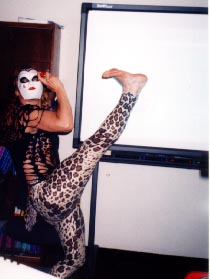
CYBERPERFORMANCE AS AN ACADEMIC RITUAL
by Professor Julia "Evergreen" Keefer,
NYU
With the widespread use of the internet, education is undergoing a revolution as significant as what happened in Classical Athens. The new media are transforming teaching and learning, but what happens to the professor? Is she an "endangered species" like Professor Keefer in the above photo? How must the professor evolve to transform teaching and be transformed by her students and the media? I will discuss a new kind of professor-- an "organic" professor who takes a holistic approach to disciplines, and a dramatic approach to teaching, creating Cyberperformances as Academic Rituals. The "organic" professor of the inorganic net differs from the specialized, tenured, academic-press publishing scholar of the twentieth century. This new "organic" professor must be more creative than critical, multidisciplinary, iconoclastic, provocative, someone with a rich traditional knowledge and cutting edge cyber skills, able to play with and manipulate intellectual capital anywhere. Gone is the security of tenure: now one survives by being well-conditioned in the brain gym, rather than having just memorized, analyzed and recorded a specific body of knowledge. In the cyberperformance, the organic professor is able to act, direct, change roles in the chameleon-like fashion necessary for successful functioning in the internet age. This new professor has to be a braingym trainer, a student, a cybershrink, a child, a clown, a Socratic bee stinger, and an internet black belt conferencer to play at all these roles.
The organic professor is faced with great teaching challenges in the 21st century. The common complaints regarding online education, aside from work/money ratio for the overworked professor, are that it desocializes, that it requires too much independent learning and motivation, that students can get lost in cyberspace, that they can't meet deadlines, and that there is not enough central focus to bring a class of asynchronous learners together. Even meatspace classes are suffering from problems with students who lack discipline, the ability to complete deadlines, to work at their optimum potential. As a cyber-enhanced organic professor at NYU, I have developed "cyberperformances" to solve these problems.
With the proliferation of digital universities, bricks and mortar institutions must re-evaluate their meatspace presence and redefine their rituals. We usually picture the academic ritual as a great amphitheatre filled with somber looking people sweating in well-garnished caps and gowns. Presidents and Deans pontificate about the future of education as graduates dutifully file up to accept diplomas and awards. The smaller rituals of end-of-semester parties rarely rise above the social. Cyberperformance is a new academic ritual that encourages play, improvisation, showmanship, and communication with the global community and the institution, while still addressing the same themes of accomplishment and separation, as well as dealing with the conscious and unconscious conflicts in the academic community.
In this paper I will document or describe five cyberperformances: Cyberperformance I: Humans and Nature, 2 May, 1998 at New York University, Cyberperformance II: Self versus State, 19 December, 1998 at New York University, Cyberperformance III: Educational versus Commercial Web Development, 28 April, 1999 at Polytechnic University, Cyberperformance IV: Heat Wave 99: Characters Sizzling in Time, on August 4 at NYU, and Cyberperformance V: The Century, from 200 Years of Jokes and Mistakes on December 18, 1999. I will discuss the rules and ingredients of this genre within the performance tradition, and its theoretical implications for a more effective use of education and technology.
The pedagogical objectives of Cyberperformance I were to help students develop a sense of argumentation, of Cyberperformance II to enhance cross-cultural understanding and to develop an empathy for characters and authors in global literature, of Cyberperformance III to empower students with better oral and written communication skills and have them really explore the differences and similarities between academic and industrial web development, of Cyberperformance IV to bring to life some of the great fictional characters who transcend time and place in the Western canon, and Cyberperformance V to have students write, think about and criticize the jokes and mistakes of this century.
The breaches were: to heal the silent rift between the computer literate and illiterate, to heal the bias and prejudice I had experienced when I first taught global literature, and to bridge the gap between the corporate and the traditional educational responses to learning online, as well as to rip the electronic cocoon that separates students in computer lab classrooms, to survive Heat Wave 99, and to repair our sociological attention deficit disorder syndrome by examining the jokes and mistakes in the century as a whole.
My role in Cyberperformance I was to be the performance shaman, using every dance and eastern mindbody technique to play the "professor as endangered species" in an effort to make the business and sociology majors less inhibited and restrained. In Cyberperformance II I wore a black wig and spectacular red azalea mask and was psychically and physically ready to improvise as the chinese communist Red Azalea reincarnated as Jean-Paul Sartre. But some of the students were excellent performers, and once they began to strut their stuff, I took off my mask and listened attentively as a regular audience member. In Cyberperformance III I dressed up as a Yuppie in a business suit because the students wanted everyone to look corporate. In Cyberperformance IV I gave into the heat with sunglasses, shorts, beer and pizza, and in Cyberperformance V who know what will happen!
By using cyberperformance as a creative combination of meatspace,(our everyday, empirical reality,) cyberspace, (student web sites projected on the big screen, as well as synchronous communication with people in other locations) and deepspace, (the improvisational and dramatic outpourings of our individual and collective conscious and unconscious emotions and desires), I seek to develop a theatrical ritual with non-professional performers that satisfies a need in the everyday life of the academic community. As such my version of cyberperformance is not only to fulfill a pedagogical purpose but also to ritualize a conflict in the academic community, and to heal the breach with catharsis and redressive action.(Turner)
RULES for using Cyberperformance as an Academic Ritual
1) A cyberperformance is a dramatic intersection of cyberspace (web sites projected on the big screen, optional internet conferencing and other synchronous communication), meatspace (our everyday phenomenal reality), and deepspace (the improvisational and emotional eruptions that occur during the event.)
2) Even when scripted, each cyberperformance is unique because some of it is always unpredictable and improvisational, as it responds to conscious and unconscious conflict in the academic community.
3) Meatspace is multi-sensory, using smell, taste, and touch as well as sight, sound, and hearing. Students are encouraged to dress up, perform physically as well as verbally, share food, and mingle in different ways.
4) Cyberspace must be live, which means that we see web sites on the internet and engage in synchronous communication with other places in the world when appropriate.
5) Lines are blurred or interchangeable between audience, performers, surfers and screen.
6) Cyberperformance is didactic, unlike some theatre that is pure entertainment. Because it is connected to the educational portion of the internet and takes place in an academic setting, there are always "messages," and things to learn.
7) There must be some kind of dramatic conflict, tapping into the secrets of "deepspace," or it's a multimedia presentation.
8) There is no dead space-- timespace is used in linear and nonlinear ways.
9) It should affect some change in the community afterwards reflecting the joy, angst and rhythms of academic rituals such as curiosity, obstacles, growth, resistance, fear, transference, accomplishment, independence, and separation.
10) The electronic presence transforms and continues the cyberperformance energy as permanent web sites as the imploded meatspace/deepspace performance explodes into cyberspace.
CYBERPERFORMANCE
I: HUMANS AND NATURE 2 May 1998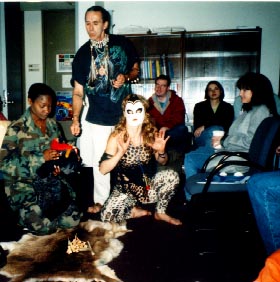
As my students designed their Humans and Nature web site for my writing class at NYU, I sensed it had become an enormous iceberg, in need of melting in the sun in some kind of dramatic, combustive way. (Cyberspace:the sea, web sites:the iceberg, cyberperformance:the meltdown). For the international Hawaiian online conference I ran a MOO on a paper I wrote about how the internet changes the conventional classroom (Keefer TCC98:"Combining Meatspace, Cyberspace and Deepspace") and I realized that for the classroom to work in the twenty first century, it must give the students something they cannot get online, cannot get from traditional lectures, collective chat, or even multimedia. I had given several multimedia presentations for faculty and realized it was just an explanation and elucidation of what was already on the screen. I was also disturbed by what was happening to the students' work in the cyber-enhanced writing research classes.
The webfolios of graphics, poetry, interviews, essays etc. provided the right brain counterpart to traditional left brain research in the MLA and APA styles, and this combination gave the work more depth than before. However, argumentation was missing. In the fluid world of hypertext, they had trouble developing their thesis and even more trouble defending it. They lacked a sense of conflict. At first I thought they just needed more lectures on logic, but after expounding on Aristotelian, Boolean and fuzzy logic for hours, I realized they were missing something more basic-- a sense of audience.
One day in the computer lab, I looked at all their bodies slumped forward over the keyboard, their fingers and wrists cramped from hours of typing, clicking and scrolling, their feet curled up on the floor, their neck and back muscles tight and bunched up. Their eyes had the glazed look of drug addicts, and their auras were grey and transparent as if they were about to dissolve into the screens themselves. As a fitness specialist as well as a multidisciplinary writing professor, this is a side effect of cyberspace I abhor. No matter how wild and wonderful are adventures are in cyberspace, we cannot let our biological bodies disintegrate. A cyberperformance is a way for cyber script writers to experience kinesthetic immediacy and wake up those dead bodies.
I scheduled a room and time for the cyberperformance and advertised it online but there were no rehearsals. I told the students to prepare a short talk on their subject, to bring artifacts on the Humans and Nature theme, and to make sure their webfolios were completely uploaded. We decided that the socioeconomic group would go first, then communications, then health science. I had two computers, a few screens, and the new Smart Board, all hooked up to the internet, at my disposal. I wanted the "performance" to be spontaneous and unpredictable because the web sites were already scripted. The students were not performers. In fact some of them had never even seen live theater. It was a multi-cultural, multi-disciplinary group of all ages. Some were computer savvy and some had never even touched a computer before the class began. The class was a Writing Workshop II expository writing and research methodology course, required for all majors. One of the students, Michael Harkins, who owns a computer consulting company, assisted me in web design and technological trouble-shooting.
The room was small, but big enough for three screens and computers, a Smart Board and a blackboard and about 30 chairs, a table and the bear rug and props. I wanted an implosion in meatspace to explode into cyberspace. If the room had been an auditorium, it would have been too easy to get out, to avoid conflict. I immersed myself in it several days before to see what it made me feel like. It was claustrophobic, like an electronic cave with screens and boards on three walls, and heavy Venetian blinds blocking out the sun. I kept them closed. The ceiling was so low it squished the top of my head when I stood on a small table. There was a rug and chairs but I arranged the chairs randomly so people would sit on the floor as well.
The night before the cyberperformance, as we were setting up, I feared that it would turn into another "multimedia presentation," especially because the students were getting stage fright when they heard Chairs of Departments and Deans would be there. I told them to wear costumes but they felt too self-conscious. That night I wandered around my apartment, sleepless, looking for a way to bring this performance to life. I gathered a costume together of leopard skin rags from a dance I did ten years ago, a wig from the same period when I was trying to be a musical comedy star, and a "crying" mask that had developed a life of its own covered with cat hair. I put on the costume and knew it was a success because it scared my cats to death. I decided to go all the way and dress up in leopard skin rags as an endangered species, thereby synthesizing the Humans and Nature theme with the anxiety over the survival of the professor in the information age. But I no longer felt "transparent," shielded in my cyber-induced, electronic trance. I was now vulnerable again and had to "double" myself, to put on masks and wigs to become a character. (Artaud 1958)
Then I pulled out an old copy of Richard Schechner's Environmental Theater and began reading about shamanistic performance. I was particularly struck by the following: "Shamanistic performance is a protagonist-antagonist conflict by means of which the secret wishes of the community are exposed and redistributed." (1973:189) In the flyer I had advertised that there would be a shamanistic performance, because many of the students were doing research projects on shamans. Juliet Paez had gone to Arizona over spring break and found one in the parking lot; Abdoulie's grandfather was a shaman and he wrote about how the current African leaders were manipulating shamanism to rule the people as despots. Michael Harkins was doing a cross-disciplinary study on computer shamans because he owns a computer consulting company, and Brigitte Aponte found a shaman in the rainforest while vacationing in Puerto Rico. Health science majors did studies on healers as shamans.
By focusing on shamanism, I could illustrate cross-disciplinary
research more effectively and simply, showing how the disciplines of computer
science, political science, health science, literature, psychology, philosophy
and anthropology all provide different perspectives or crosses on the understanding
of shamanism. For props I rounded up objects in my apartments: a wigwam of fur
and leather, a pumpkin, an Eskimo doll. Students brought bear rugs, pottery,
tea and cups, incense, and herbs to burn.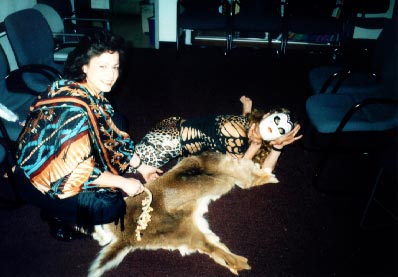 The Puerto Rican shaman entered beating a huge drum. As we set up the space
on Saturday morning, it reminded me of a condensed, electronic version of The
Performing Garage in the seventies. I hoped the audience and performers would
mingle as they had in Schechner's performances, but since my students weren't
performers, I knew it was going to be very difficult.
The Puerto Rican shaman entered beating a huge drum. As we set up the space
on Saturday morning, it reminded me of a condensed, electronic version of The
Performing Garage in the seventies. I hoped the audience and performers would
mingle as they had in Schechner's performances, but since my students weren't
performers, I knew it was going to be very difficult.
I was expecting the conflict would come from a student getting mad at me because she couldn't fulfill the assignments; instead a more cosmic conflict developed between the Puerto Rican shaman and the computer guru over who was the real shaman. Although I don't like to delude myself with feelings of specialness or omnipotence, I was acting the role of a kind of shaman, a "trickster," as the Puerto Rican shaman Carlos Chavez described me, a social stimulant and irritant who was really trying to turn a multi-media presentation into a cyberperformance. Through my body and memory I combined modern dance, mask transformation, kick boxing, wrestling, comedy, improvisation and therapy with my role as professor. The only prop that worked for me was the bear rug because I could roll around in it as the endangered species. My goal was to unite information with emotion and memory, to ground expression in a meatspace reality with oral polemics and conflict, and to provide a venue for display, exhibitionism and communal interaction.
Yet Chavez, the Puerto Rican shaman, was the real antagonist
who placed himself in every scene, terrifying, fascinating and annoying spectators
as much as any goblin, wolf or bad guy. The computer shaman, Michael Harkins,
turned himself into the protagonist because the room was really his show-- in
spite of the symbolic artifacts, it was a room designed and used exclusively
for technology.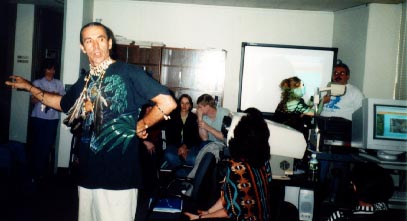 Harkins' research
was on the mysterious, sometimes omnipotent power of computer shamans whose
drugs are nicotine and coffee, stimulants that focus them in the chaotic environment
of technology. Through his acquired knowledge, the computer shaman can divine
trends in the technological future, apply this knowledge to weather the chaos
of change, buffeting the enterprise, and most importantly, make possible technology
transformations to improve the enterprise or cure what ails it. (Harkins 1998)
Harkins' research
was on the mysterious, sometimes omnipotent power of computer shamans whose
drugs are nicotine and coffee, stimulants that focus them in the chaotic environment
of technology. Through his acquired knowledge, the computer shaman can divine
trends in the technological future, apply this knowledge to weather the chaos
of change, buffeting the enterprise, and most importantly, make possible technology
transformations to improve the enterprise or cure what ails it. (Harkins 1998)
Harkins goes on to describe the magical properties of the computer:
"This animated machine requires proper handling to maintain its benevolent demeanor, and must also be protected should improper discourse unleash its demonic potential. Misuse or neglect of these spirits can start wars, disrupt traffic, cause loss of livelihood and render business inoperative. The soul that inhabits a computer is a fickle and mysterious power, which requires ritualistic observance of its needs, reconciliation when the needs are not met, and prompt intervention in case of security breaches." (Harkins 1998)
In order to enhance the conflict's energy but alienate it from personal attack, I went over to the computer guru and I stood on a table and pressed my head against the ceiling when the fight got out of control. I caressed the screen lovingly, gently, purposefully, but when I looked closely, there was nothing there, because the bright colors are only projections on an empty surface. I returned back to the "real" people. For four hours I was in a hyper-aroused, "ectstatic," multi-focal state (Artaud 1958), the opposite of the clear, calm, playful focus I experience online. As a performer I was never self-conscious, but only judged my performance in terms of the flow of the entire event, like a kinesthetic, not a visual-spatial, director. Ironically I left the performance a few minutes early to teach two hours of aerobics at Coles gym. I was happy the performance could exist without me.
THE AUDIENCE
I felt I was listening to the natural rhythms of everyone and
encouraging the unfolding of the most inevitable conflict. What ensued was a
traditional Aristotelian protagonist-antagonist conflict between two men with
a crisis, climax and denouement, imitating the rise and fall of the male orgasm.
In spite of my hyperaroused, multi-orgasmic state and the fear of some of the
women and men, Cyberperfomance I was essentially Aristotelian in structure.
A passing surfer who happened to see the cyberperformance advertised online,
Sheldon Siporin, said he was surprised it was so "linear;" he was expecting
a hyperdrama (Deemer 1995) with branching narratives and interactive choices
(Murray 1997). Although the environment was multi-focal and there were plenty
of distractions, it did fall into a central dramatic conflict which I encouraged
but did not initiate. Even performances like the Jabberwocky by eight year old
Matthew Harkins, Abdouleh Bandoulie's
tales of shamanism and corrupt African political leaders, Laurie Cody's convincing
naturalistic presentation (Stanislavsky-style acting) of a Gulf War veteran
with a baby killed by biological agents,
Abdouleh Bandoulie's
tales of shamanism and corrupt African political leaders, Laurie Cody's convincing
naturalistic presentation (Stanislavsky-style acting) of a Gulf War veteran
with a baby killed by biological agents, 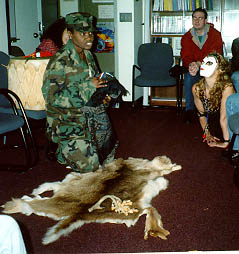 and
the factual discourses on man's rape of the environment only enhanced the conflict
between technology and nature: which God or Shaman do we want to serve?
and
the factual discourses on man's rape of the environment only enhanced the conflict
between technology and nature: which God or Shaman do we want to serve?
The seeds of this drama came from the dialectic of the course
Humans and Nature, and the breach in the community that made the performance
possible. This breach was the warfare between education and technology, machines
and professors, teaching in meatspace or cyberspace. Everyone in the room had
a vested interest, conscious or unconscious, in the outcome of the fight between
the computer guru and the Puerto Rican rainforest shaman. The cyberperformance
ritualized this breach with the crisis and redressive action. (Turner) Afterwards
there was a feeling of euphoria that spilled into afternoon classes and workshops
and faculty parties at night. Somehow computers were no longer malevolent gods--
they had been reintegrated into the community. What started out as a drama became
a script through the web site, theatre through computers and performers, and
finally social drama and narrativity (Schechner, Turner et al.) through the
cyberperformance. This is how I explain the extreme reactions of the audience
from running away in fear, to giggling, to standing up to fight. 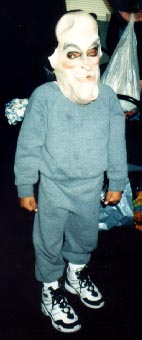 However
students spent the next year talking about the cyberperformance, and even commended
it, when giving speeches or receiving awards, as their most memorable academic
experience.
However
students spent the next year talking about the cyberperformance, and even commended
it, when giving speeches or receiving awards, as their most memorable academic
experience.
CYBERPERFORMANCE
II: SELF VERSUS STATE 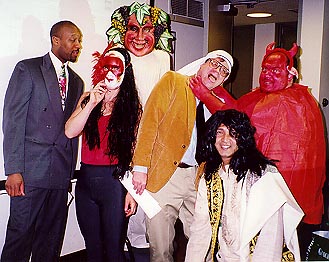 will
be aptly remembered as the day (19 December 1998) when an American president
was impeached for lying about an extra-marital affair. It was sponsored by my
Twentieth Century Writers class (a global literature course) and Writing Workshop
II, an advanced expository writing and research class centered around the theme
of Self versus State. The pedagogical objectives of this performance were to
enhance an appreciation of and tolerance for cultural diversity, to unite the
linear world of great literature with multifocal electronic communication, to
empower students as characters or authors from the novels and plays, and again
to bring computers and the electronic ambiance to life in bricks and mortar
academe.
will
be aptly remembered as the day (19 December 1998) when an American president
was impeached for lying about an extra-marital affair. It was sponsored by my
Twentieth Century Writers class (a global literature course) and Writing Workshop
II, an advanced expository writing and research class centered around the theme
of Self versus State. The pedagogical objectives of this performance were to
enhance an appreciation of and tolerance for cultural diversity, to unite the
linear world of great literature with multifocal electronic communication, to
empower students as characters or authors from the novels and plays, and again
to bring computers and the electronic ambiance to life in bricks and mortar
academe.
As editor of the Journal of Online Education for the World Association for Online Education (WAOE), I have a strong interest in the issues of cultural diversity, and specifically accepted the course because I could develop a curriculum of global literature. However the first time I taught the course in the summer of 1998, I noticed two problems: one was that the students retained their cultural and gender biases so tenaciously that they often could not enter the lives and feelings of other people; and the other was that they tended to lose their focus as they ploughed through the enormous reading list. To solve these problems, I had students pick characters early in the semester and asked them to create a webfolio of creative and critical writing seen through the eyes of that character. This gave them a focus and a sense of empathy for someone other than themselves. Some of these webfolios were very imaginative. (See Twentieth Century syllabus:)
The writing workshop students assumed characters such as Socrates,
a schizophrenic real estate investor, the Rainbow Mother of creativity, and
a Cyberhousewife addicted to the internet, but their primary focus was to write
a standard college research paper and present their findings at the performance.
Because I gave the students more freedom and did virtually nothing during the
cyberperformance but dress up as Red Azalea, some interesting things happened.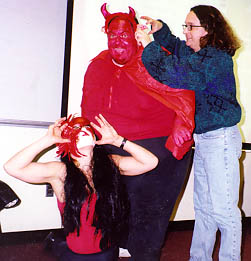 First of all the ambiance was one of joyous celebration, with subtle power struggles,
but no singular dialectic. The only conflict occurred when an 800 pound Satan
complete with red paint, horns and tails, passed out chocolates to everyone
in the building, including President Jay Oliva who appeared in the elevator
after attending a real funeral on the first floor. President Oliva must have
thought he had stopped off in hell on his way to the memorial service, especially
because this event occurred on Saturday evening in a grey and dismal computer
science building that would normally be empty.
First of all the ambiance was one of joyous celebration, with subtle power struggles,
but no singular dialectic. The only conflict occurred when an 800 pound Satan
complete with red paint, horns and tails, passed out chocolates to everyone
in the building, including President Jay Oliva who appeared in the elevator
after attending a real funeral on the first floor. President Oliva must have
thought he had stopped off in hell on his way to the memorial service, especially
because this event occurred on Saturday evening in a grey and dismal computer
science building that would normally be empty. 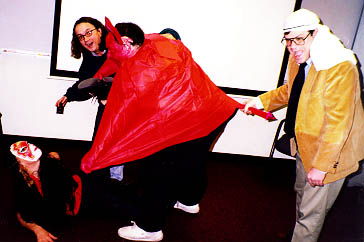
This event was a little more technologically sophisticated than
Cyberperformance I with a live broadcast, sound and moving images, as well as
an internet connection on the big screen. When I think of what Neil Postman
has written about gods that fail in his book The End of Education (1994),
I can understand why many of the characters were gods: The God of Untimely Deaths,
The God Who Died by the Nile, the God of Small Things, The God of the Internet.
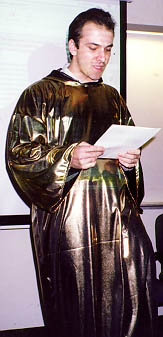 Students are still searching for
a mythology to give meaning to their lives. However it was Einstein who became
the Master of Ceremonies.
Students are still searching for
a mythology to give meaning to their lives. However it was Einstein who became
the Master of Ceremonies. 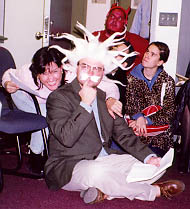 Was
it because Larry Zeller, who played Einstein, had the most talent for stand-up
comedy, or because Einstein may have been the most influential thinker of the
twentieth century, or both? After reading all the classics, the students preferred
a book by Alan Lightman about distortions in time and space, called Einstein's
Dreams. Virginia Woolf (Kristen Bernard) and Gabriel Garcia Marquez (Juliet
Paez) had beautiful webfolios but not too much dramatic influence in the cyberperformance.
The Savage from Brave New World (Mary Kursar) turned into a backwoods
southerner who enhanced Einstein's stand-up performance.
Was
it because Larry Zeller, who played Einstein, had the most talent for stand-up
comedy, or because Einstein may have been the most influential thinker of the
twentieth century, or both? After reading all the classics, the students preferred
a book by Alan Lightman about distortions in time and space, called Einstein's
Dreams. Virginia Woolf (Kristen Bernard) and Gabriel Garcia Marquez (Juliet
Paez) had beautiful webfolios but not too much dramatic influence in the cyberperformance.
The Savage from Brave New World (Mary Kursar) turned into a backwoods
southerner who enhanced Einstein's stand-up performance.
The students were bent on supporting, helping, enhancing and re-inforcing each other rather than fighting the way they did in Cyberperformance I. Einstein acted a lot like Billy Crystal during the academy awards, bringing people on and off, with a ribald sense of American comedy. In fact the presentation was American in tone with American jokes and presentation. Because we were lucky enough to have students whose native languages were Spanish, French, Japanese, Chinese, Korean, Indian, Roumanian, Greek, Russian, Italian and Portuguese, I had asked them to do a small part of their presentation in these languages and to speak them as often as possible. They refused to do it and a very brief cacophony of foreign tongues could only be heard when Einstein asked everyone to sing their national anthems. The voices quickly melted into, "Oh, say can you see.." as they all sang the American national anthem. Isn't this what is happening with our "global magazine," the internet? The students' desire, conscious and unconscious, to homogenize global diversity was stronger than my syllabus that encouraged it. They had spent their lives trying to fit into the American mainstream even though their web sites dutifully reflected the goals of the course.
The other unconscious thing that erupted during the performance was the students' antipathy towards the depressing, existential, apocalyptic literature of the twentieth century. Whenever a presentation became too bleak, Einstein the comic was ready with a joke, however lame, and the God of the Internet had some kind of cheerful eighties pop song to play, such as Gloria Gaynor's "I will Survive." So instead of my theme of Self versus State the "deepspace", collective unconscious of the performers created a reaction to the course--homogeneity and humor instead of diversity and angst. In addition to the NYU and Manhattan communities, students attended from Vassar, Columbia and Amherst because it was advertised on my web site, and said they wished they went to NYU instead of their Ivy League schools. Everyone loves a party, but more importantly students need performative goals in an age where more and more learning takes place at individual computer terminals.
CYBERPERFORMANCE
III: EDUCATIONAL VERSUS COMMERCIAL WEB DEVELOPMENT, 28 April 1999 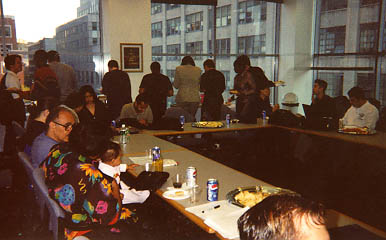
Because of my effervescent web sites, I got a job teaching Technical Writing and the Internet to computer majors at Polytechnic University. At first I was overwhelmed by their technical expertise. They already knew how to build, fix and program computers and were taking this web design course to give them a break from physics and engineering, and to enhance their commercial marketability. Yet one third were already working part-time as professional designers. I was supposed to teach them Front Page, which I still haven't mastered; instead they taught me and the class advanced HTML, Java, advanced Photoshop and the essentials of commercial web design.
I sat patiently in the back wondering what I could do for them when a student asked me what a "paperback" was. She was a senior and had never read anything but technical manuals and high school texts. In fact, they all hated to read and when surfing the net, clicked out of sites with "too much boring text." I tried to be open-minded because their logical/mathematical/visual/spatial skills certainly exceeded mine. Their web sites were clean, crisp, short, with as little text as possible. Almost everything was recombinant or plagiarized, i.e. pulled off other professional web design sites. Yet their recombinant look was attractive, professional, and very easy to understand.
As they began to work on their final projects, some of the students opted to construct educational sites. One woman created an imaginary Creative Poetry Company to design a multicultural poetry site for Polytechnic University even though there are no poetry classes in the curriculum. Another student chose a kindergarten school, another an online course in sequential mathematics for the New York ciy public school system, and a fourth a better online version of the class I had already taught. The music director designed a wild cyber-enhanced digital photography class for an imaginary professor Harry Hill. One ambitious student designed a search engine, ALINGO, to compete with Alta Vista, Yahoo, and Excite. The commercial sites included real projects for Chase Manhattan and Coalco Com and small stores and businesses, (Designer Keepsakes, Universal Computer, and Neon Eagle), as well as several utopian sites based on companies the students made up.
The students organized everything-- the email listserv, the food, the technical back-up, the musical direction etc. I did help them with public relations and advertising, speech and writing skills so that by the time of the cyberperformance they were able to stand up in front of an audience and sell their goods, no small feat for very young (18-21 year old) Russian and Asian immigrants with thick accents. For these engineering students, the most emotionally combustive moment of their academic career was talking into a mic in a huge auditorium with their web sites displayed on the big screen. Unlike the other cyberperformances, I decided we needed at least two rehearsals. The students had spent the semester encased in their electronic cocoons and had never acted physically like a class. In the computer lab the digital delights upstage the conventional eye contact, give and take of conventional classrooms. In the auditorium in the dress rehearsal they had nothing to hide behind. In fact for the dress rehearsal, none of the machines and gadgets were there. We had the performance room, but the equipment-- computers with internet connections-- never arrived. The students had to spend the entire evening talking into the mic, pointing to imaginary sites on a screen that wasn't there. This was a good experience for them because they were forced to project, make eye contact, get over their stage fright, and deal with a bored, restless audience of peers.
The performance room was large, comfortable, and carpeted with soft conference chairs, huge bay windows looking out on Metrotech Center, a separate coat check room and a fully equipped kitchen. The school had arranged to cater a dinner for us afterwards. As a one-time adjunct, I got everything I asked for and more. I sensed three strong needs among the students-- one was to create a campus-like, party event because they never had these kinds of events; the second was to prove to themselves, me, and the audience that they could have taught the course themselves without me; and the third was to convince me of the importance of worshipping the Corporate God as the source of practical well-being. After combing through my wild, unconventional web site, and watching me wear the same aerobics outfit to class every week, they knew the Corporate God had somehow forsaken me. Their immigrant families were counting on them to make good in America, and their technical education at Poly was the smart start they needed. Therefore I chose the theme Educational versus Commercial Web Development.
The costumes were pretty wild and extravagant for the first
two cyberperformances, but this time the students decided that everyone would
wear a suit and tie. Dressing up as a Yuppie was even more of a disguise for
me than dressing in a leopard outfit with mask and wig. Since the students spent
the semester staring into computer screens, I organized the room into one huge
conference circle so that they ate for three hours Thanksgiving-style.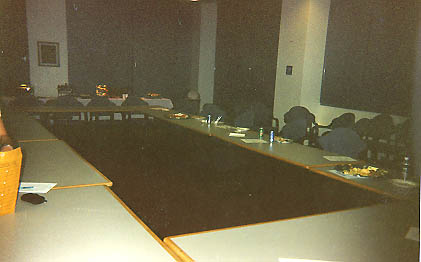 It was the first time during the semester that they could stare into each other's
faces. This was an excellent way to centralize the focus among the multifocal
children-of-chaos generation. However, for children-of-chaos, their presentations
were by far more organized than anything that took place at NYU. Without engaging
in any argumentation, the students and the audience realized by the end of the
cyberperformance that one could pay the price of some loss of creativity and
freedom to work for a large corporation.
It was the first time during the semester that they could stare into each other's
faces. This was an excellent way to centralize the focus among the multifocal
children-of-chaos generation. However, for children-of-chaos, their presentations
were by far more organized than anything that took place at NYU. Without engaging
in any argumentation, the students and the audience realized by the end of the
cyberperformance that one could pay the price of some loss of creativity and
freedom to work for a large corporation. 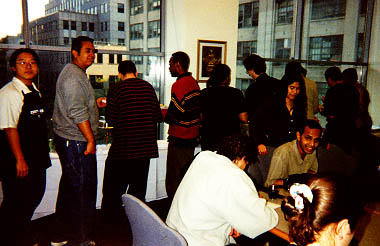 The
director of public relations attended and said the cyberperformance was the
best thing that had happened to the university in ages.
The
director of public relations attended and said the cyberperformance was the
best thing that had happened to the university in ages.
CYBERPERFORMANCE
IV: HEAT WAVE 99:CHARACTERS SIZZLING IN TIME 5 August 1999
Even under the worst of circumstances, when the professor's air conditioner breaks during the hottest, driest, most polluted month in New York city history and the students are sleepy, desultory and apathetic, a cyberperformance can save the day. My Introduction to Literature was filled with business, dental hygiene, and psychology majors who wanted to spend some easy summer credits reading novels on the beach. However, the curriculum was anything but easy: Oedipus Rex, Hamlet, Ulysses, A Tale of Two Cities, and poems and stories of their choosing. After taking them to poetry readings and elegant buffets in a beautiful townhouse, an exciting avant-garde Off-Broadway production of Hamlet by Richard Schechner, films of Ulysses and A Tale of Two Cities, half of the class dropped out. I had pretty well given up when I decided we would give into the heat with a small summer sizzler cyberperformance with pizza and wine.
At the last minute, students worked hard to arrange the semester's work in webfolios on various themes related to the class theme. There is nothing like the performative pressure of publishing on the world wide web to make students concentrate. The characters were as follows: Gratia, the Neo-Deconstructionist, Rosie, Stacy the Dutiful Irishwoman, Me as Aristotle reincarnated as a body builder, Zach the Defending Attorney, Mary the Prosecuting Attorney, Hope the Poet of Light. As we sat around a conference table drinking wine and eating pizza, I realized that the projection of the semester's work on a huge screen will facilitate excellent oral presentations, discussions, and give a sense of form and completion to even the laziest semester. The computer screen was there saying-- "I remember, even if sun, wine and heat have sizzled your brains." "I can make your work look pretty; I can broadcast your beauty to the world" "I can keep the focus."
CYBERPERFORMANCE V: THE CENTURY FROM 2000
YEARS OF JOKES AND MISTAKES 
took place on December 18. 1999 at NYU. We had an interesting
combination of frogs, opera singers, research on Indian mass media and a number
of jokes and mistakes that Americans have committed in this century! Only Professor
Keefer dressed up as Santa Claus.
CYBERPERFORMANCE VI: E-COMMERCE: CONSUMERS VERSUS COMMUNITARIANS
 took place at Polytechnic University
on April 27, 2000 in a large amphitheatre. During the semester we tried to avoid
flat advertising and blatant consumerism in favor of developing a sense of community,
imparting information, listening to surfers, and changing the website frequently.
The Poly students created a number of "sticky" sites on all aspects
of e-commerce and education.
took place at Polytechnic University
on April 27, 2000 in a large amphitheatre. During the semester we tried to avoid
flat advertising and blatant consumerism in favor of developing a sense of community,
imparting information, listening to surfers, and changing the website frequently.
The Poly students created a number of "sticky" sites on all aspects
of e-commerce and education.
CYBERPERFORMANCE
VII: The Global Screenwriting Showcase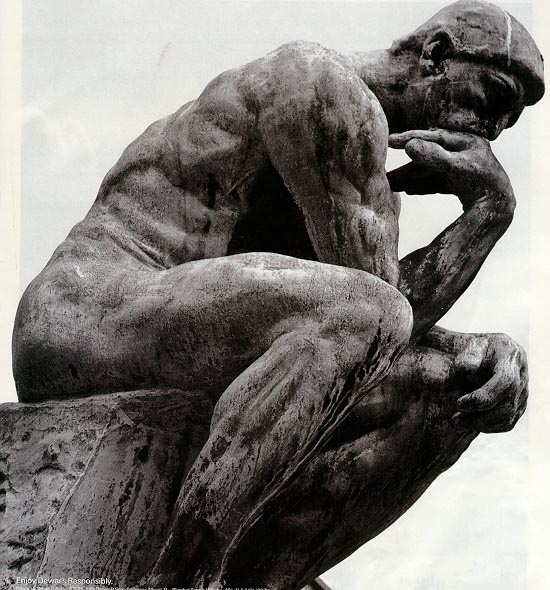 didn't really happen on April 29, 2000 because online students prefer to stay
online. They like the focus, the discipline, the lack of distraction.
didn't really happen on April 29, 2000 because online students prefer to stay
online. They like the focus, the discipline, the lack of distraction.
CYBERPERFORMANCE
VIII: Looking for Health, Wealth, Love and Knowledge Online took place on
May 6, 2000 at NYU. Suddenly in the middle of the show, we all got very depressed,
listening to these desperate accounts of lost dreams.  Like
so many of the technological extensions of the twentieth century, cyberspace
fosters our narcissism, particularly when we are looking for love or wealth
online. At this cyberperformance we investigated the difference between reality
and fantasy and why so many people construct sandcastles online. The tragedy
is that few of them realize they are sandcastles.
Like
so many of the technological extensions of the twentieth century, cyberspace
fosters our narcissism, particularly when we are looking for love or wealth
online. At this cyberperformance we investigated the difference between reality
and fantasy and why so many people construct sandcastles online. The tragedy
is that few of them realize they are sandcastles. ![]()
CYBERPERFORMANCE
IX: Eco-Disciplinary Research took place on August 9, 2000 at NYU. This class presented interesting research
projects on different aspects of the environmentalism versus development, West
versus East debate. The projects were original and the argumentation the best
Professor Keefer has seen. This class needed little coaching: they were disciplined,
savvy, motivated, and interesting. The internet gave them a constructive arena
to air their views. In contrast to the delusions and sandcastles of Cyberperformance
VIII, this event showed the promise of the internet because it focused on research
and simple exchange of ideas. However the consensus was depressing: we are turning
our cities into insufferable slabs of concrete and should try to get property
in the country as soon as possible.
took place on August 9, 2000 at NYU. This class presented interesting research
projects on different aspects of the environmentalism versus development, West
versus East debate. The projects were original and the argumentation the best
Professor Keefer has seen. This class needed little coaching: they were disciplined,
savvy, motivated, and interesting. The internet gave them a constructive arena
to air their views. In contrast to the delusions and sandcastles of Cyberperformance
VIII, this event showed the promise of the internet because it focused on research
and simple exchange of ideas. However the consensus was depressing: we are turning
our cities into insufferable slabs of concrete and should try to get property
in the country as soon as possible. 
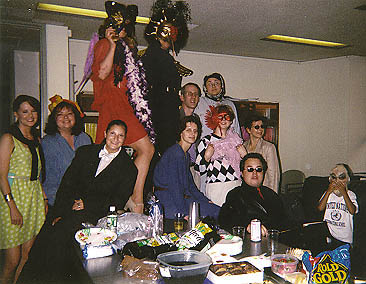 took place on August 15, 2000
at NYU. The students developed a intense literary, visceral, dramatic, psychological
sense of character and took those characters on an exciting journey through
twentieth century literature.
took place on August 15, 2000
at NYU. The students developed a intense literary, visceral, dramatic, psychological
sense of character and took those characters on an exciting journey through
twentieth century literature. 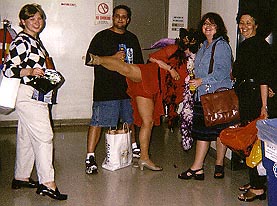
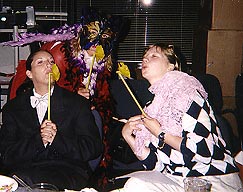
Professor Evergreen Butterfly blows wishes from the Humbert
Humberts of LOLITA. The clown puts a hoax on Mustapha Mond from BRAVE NEW WORLD
while God watches.  Zakeya from
GOD DIES BY THE NILE meditates in prison on twentieth century literature as
her son plays the monster.
Zakeya from
GOD DIES BY THE NILE meditates in prison on twentieth century literature as
her son plays the monster. Anais
Nin's husband discusses the narcissism of the twentieth century with the Gadfly.
Anais
Nin's husband discusses the narcissism of the twentieth century with the Gadfly.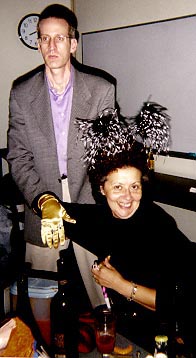
For me the goal of the organic professor on the inorganic net is to bring theatre back into the classroom. The cyberperfomance then becomes the dramatic intersection of cyberspace, meatspace and the deepspace of our unconscious, collective and individual, a performance that was born online and lives electronically ever after in its web sites, enhanced by its cathartic eruption in meatspace. I wait for the day when the entire university includes a cyberperformance as part of the commencement ceremonies!
References
Alter, Jean. A Sociosemiotic Theory of Theatre. Philadelphia: University of Pennsylvania Press, 1990.
Aristotle. Poetics, trans. Gerald F. Else. Ann Arbor: University of Michigan Press, 1988.
Artaud, Antonin. The Theatre and Its Double, trans. Mary Caroline Richards. New York: Grove Press, 1958.
Brecht, Bertolt. Brecht on Theatre, trans. John Willett. New York: Hill and Wang, 1964.
Burk, Juli. "Moov-ing Online: A New Venue for Teaching
and Making Theatre."
Darwin, Charles. The Portable Darwin, eds. Duncan M. Porter and Peter W. Graham. London and New York: Penguin Books, 1993.
Deemer, Charles. 1 September 1996. "Hyperdrama
and Virtual Development: Notes on Creating New Hyperdrama in Cyberspace."
Freud, Sigmund. Civilisation and Its Discontents, trans. Joan Riviere. New York: Dover Press, 1994.
Goffman, Erving. The Presentation of Self in Everyday Life. New York: Doubleday, 1959.
Grotowski, Jerzy. Towards a Poor Theatre. New York: Simon & Schuster, 1968.
Hargitai, Joseph and Keating, Ann. The Wired Professor. New York: New York University Press, 1998.
Harkins, Michael. "Computer Consultant as Shaman."
Joyce, Michael. Of Two Minds: Hypertext Pedagogy and Poetics. Ann Arbor: University of Michigan Press, 1995.
Keefer, Julia. 1969. "La Chute de la Tradition
Theatrale." Unpublished Master's Thesis. La Sorbonne, Paris.
1990-1991 "Through the Broken Glass" one woman show performed
in New York.
1995 "A Penal Fantasy" one woman show performed in New
York.
1996-1998 Keefer Web Site. <http://www.nyu.edu/classses/keefer>
1998 "Combining Meatspace, Cyberspace and Deepspace: How
the Internet Changes Conventional/Traditional Education"
TCC98 Annual Conference 4-9 April 1998
1999 "The Dilemma of Academic Freedom" TCC99 Annual Conference, April
1999.
"Cyberperformance II: Self versus State," New York University.
28 April 1999 "Cyberperformance III: Educational versus Commercial Web Development,"
at Polytechnic University.
"Cyberperformance IV:Heat Wave 99: Characters Sizzling
in Time: 5 August 1999 at New York University.
LaFarge, Antoinette. "A World Exhilirating and
Wrong:Theatrical Improvisations on the Internet."
Laurel, Brenda. 1993. Computers as Theatre. New York: Addison-Wesley Publishing.
McKenzie, Jon. "Laurie Anderson for Dummies."
TDR 41, no.2:2, 1997.
1998. "Genre Trouble: (The) Butler Did It," in The Ends
of Performance, eds. Peggy Phelan and Jill Lane. New York: New York University
Press, 1998.
McLuhan, Marshall. Understanding Media:The Extensions of Man. New York: McGraw-Hill, 1964.
Murray, Janet H. Hamlet on the Holodeck: The Future of Narrative in Cyberspace. New York: Simon & Schuster, 1997.
Nietzsche, Friedrich. The Portable Nietzsche, trans. Walter Kaufman. New York: Penguin Books, 1954.
Postman, Neil. The End of Education. New York: Vintage Books, 1995.
Sartre, Jean-Paul. What is Literature? trans. Bernard Frechtman. New York: Harper & Row, 1965.
Schechner, Richard. Environmental Theatre. New
York: Hawthorn Books, 1973.
Performance Theory. London and New York: Routledge, 1988.
By Means of Performance, eds. Richard Schechner and Willa Appel. New
York and Cambridge: Cambridge University Press, 1990.
Stanislavsky, Konstantin. Stanislavsky on the Art of the Stage, trans. David Magarshack. New York: Hill and Wang, 1961.
Turner, Victor. From Ritual to Theatre: The Human Seriousness of Play. New York: Performing Arts Journal Press, 1982.
Wittgenstein, Ludwig. Culture and Value. Chicago: University of Chicago Press, 1980.